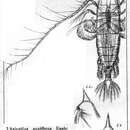en
names in breadcrumbs


Body absolutely clear
The species resembles H. oxycephalus, the latter of which is often recorded from Antarctic and sub-Antarctic seas. As discussed by Park (1988), the two species are practically indistinguishable; the only useful anatomical detail to determine acutifrons is the relatively shorter frontal spine.
Central Arctic Basin, Norwegian waters, West-Greenland waters, North Atlantic, North Pacific, isolated spots of the tropical Pacific, sub-Antarctic, Antarctic
Oceanic, epi- to bathypelagic species. Prefers deep waters, but may be found near the surface
Female:
The top of the head carries a frontal spine, which is straight and only slightly tilted forward. A1 are longer than the body by 5-7 abdominal segments. The exopodite of A2 is shorter than the first segment of the endopodite. Endopodite of the Mx with 4 chaetae. Gut without diverticuli, ovaries do not reach the feeding appendages. Abdomen is shorter that the cephalothorax by more than 5 times. Caudal rami are as long as the combined length of third and fourth abdominal segments. The genital segment is as long as the combined length of the remaining abdominal segments.